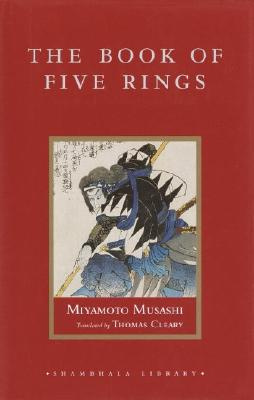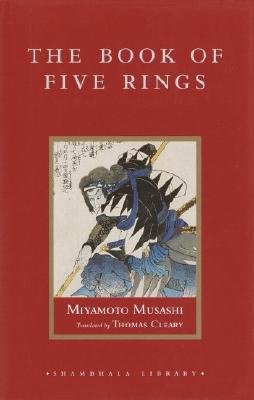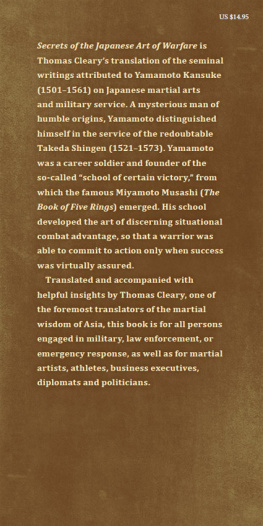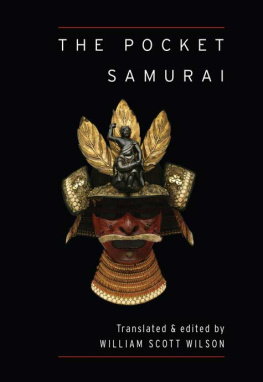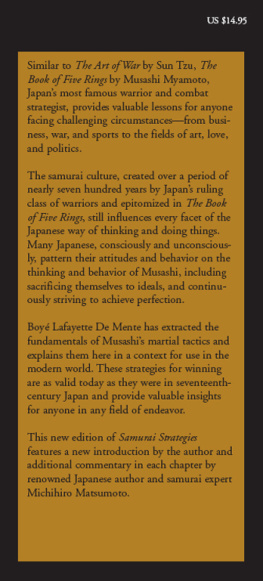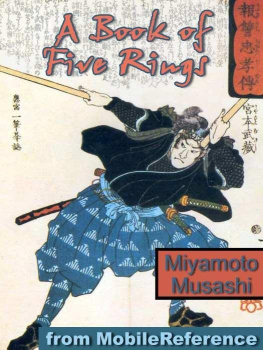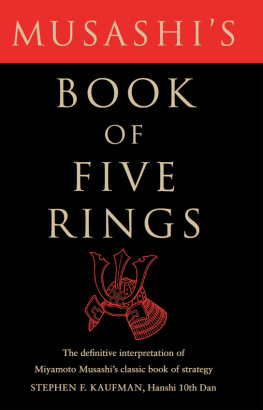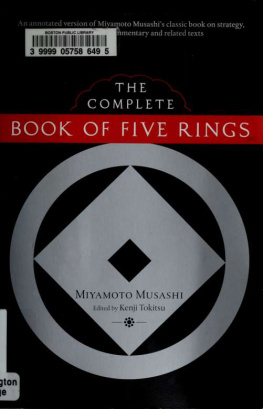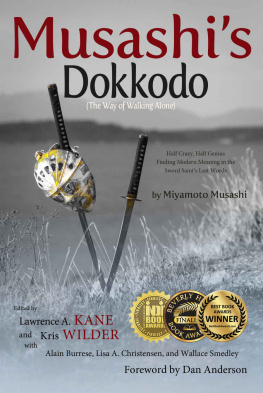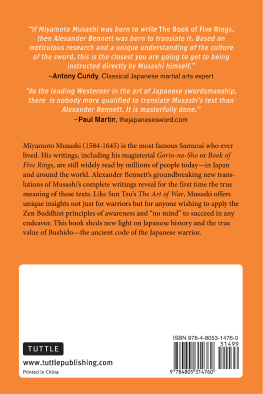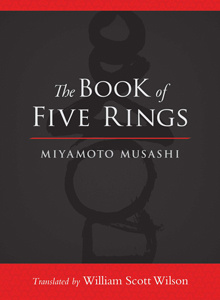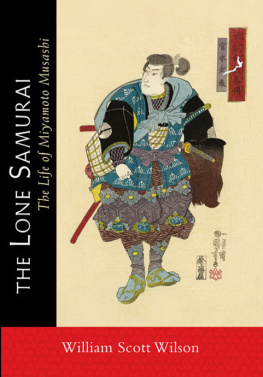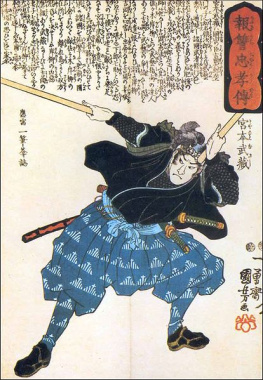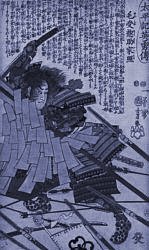I have been many years training in the Way of strategy, called Ni Ten Ichi Ryu, and now I think I will explain it in writing for the first time. It is now during the first ten days of the tenth month in the twentieth year of Kanei (1645). I have climbed mountain Iwato of Higo in Kyushu to pay homage to heaven, pray to Kwannon, [God(dess) of mercy in Buddhism. Slaegr] and kneel before Buddha. I am a warrior of Harima province, Shinmen Musashi No Kami Fujiwara No Genshin, age sixty years.
From youth my heart has been inclined toward the Way of strategy. My first duel was when I was thirteen, I struck down a strategist of the Shinto school, one Arima Kihei. When I was sixteen I struck down an able strategist Tadashima Akiyama. When I was twenty-one I went up to the capital and met all manner of strategists, never once failing to win in many contests.
After that I went from province to province duelling with strategist of various schools, and not once failed to win even though I had as many as sixty encounters. This was between the ages of thirteen and twenty-eight or twenty-nine.
When I reached thirty I looked back on my past. The previous victories were not due to my having mastered strategy. Perhaps it was natural ability, or the order of heaven, or that other schools' strategy was inferior. After that I studied morning and evening searching for the principle, and came to realise the Way of strategy when I was fifty.
Since then I have lived without following any particular Way. Thus with the virtue of strategy I practise many arts and abilities all things with no teacher. To write this book I did not use the law of Buddha or the teachings of Confucius, neither old war chronicles nor books on martial tactics. I take up my brush to explain the true spirit of this Ichi school as it is mirrored in the Way of heaven and Kwannon. The time is the night of the tenth day of the tenth month, at the hour of the tiger (3-5 a.m.)
THE GROUND BOOK
Strategy is the craft of the warrior. Commanders must enact the craft, and troopers should know this Way. There is no warrior in the world today who really understands the Way of strategy.
There are various Ways. There is the Way of salvation by the law of Buddha, the Way of Confucius governing the Way of learning, the Way of healing as a doctor, as a poet teaching the Way of Waka, [a type of poem. Slaegr] tea, archery, and many arts and skills. Each man practises as he feels inclined.
It is said the warrior's is the twofold Way of pen and sword, and he should have a taste for both Ways. Even if a man has no natural ability he can be a warrior by sticking assiduously to both divisions of the Way. Generally speaking, the Way of the warrior is resolute acceptance of death. Although not only warriors but priests, women, peasants and lowlier folk have been known to die readily in the cause of duty or out of shame, this is a different thing. The warrior is different in that studying the Way of strategy is based on overcoming men. By victory gained in crossing swords with individuals, or enjoining battle with large numbers, we can attain power and fame for ourselves or our lord. This is the virtue of strategy.
The Way of Strategy
In China and Japan practitioners of the Way have been known as "masters of strategy". Warriors must learn this Way.
Recently there have been people getting on in the world as strategists, but they are usually just sword-fencers. The attendants of the Kashima Kantori shrines of the province Hitachi received instruction from the gods, and made schools based on this teaching, travelling from country to country instructing men. This is the recent meaning of strategy.
In olden times strategy was listed among the Ten Abilities and Seven Arts as a beneficial practice. It was certainly an art but as a beneficial practice it was not limited to sword-fencing. The true value of sword-fencing cannot be seen within the confines of sword-fencing technique.
If we look at the world we see arts for sale. Men use equipment to sell their own selves. As if with the nut and the flower, the nut has become less than th flower. In this kind of Way of strategy, both those teaching and those learning the way are concerned with colouring and showing off their technique, trying to hasten the bloom of the flower. They speak of "This Dojo" and "That Dojo". They are looking for profit. Someone once said "Immature strategy is the cause of grief". That was a true saying.
There are four Ways in which men pass through life: as gentlemen, farmers, artisans and merchants.
The Way of the farmer. Using agricultural instruments, he sees springs through to autumns with an eye on the changes of season.
Second is the Way of the merchant. The wine maker obtains his ingredients and puts them to use to make his living. The Way of the merchant is always to live by taking profit. This is the Way of the merchant.
Thirdly the gentleman warrior, carrying the weaponry of his Way. The Way of the warrior is to master the virtue of his weapons. If a gentleman dislikes strategy he will not appreciate the benefit of weaponry, so must he not have a little taste for this?
Fourthly the Way of the artisan. The Way of the carpenter [architect and builder, all buildings were of wood. Slaegr] is to become proficient in the use of his tools, first to lay his plans with a true measure and then perform his work according to plan. Thus he passes through life. These are the four Ways of the gentleman, the farmer, the artisan and the merchant.
Comparing the Way of the carpenter to strategy
The comparison with carpentry is through the connection with houses. Houses of the nobility, houses of warriors, the Four houses, [there are also four different schools of tea. Slaegr] ruin of houses, thriving of houses, the style of the house, the tradition of the house, and the name of the house. The carpenter uses a master plan of the building, and the Way of strategy is similar in that there is a plan of campaign. If you want to learn the craft of war, ponder over this book. The teacher is as a needle, the disciple is as thread. You must practice constantly.
Like the foreman carpenter, the commander must know natural rules, and the rules of the country, and the rules of houses. This is the Way of the foreman.
The foreman carpenter must know the architectural theory of towers and temples, and the plans of palaces, and must employ men to raise up houses. The Way of the foreman carpenter is the same as the Way of the commander of a warrior house.
In the construction of houses, choice of woods is made. Straight un-knotted timber of good appearance is used for the revealed pillars, straight timber with small defects is used for the inner pillars. Timbers of the finest appearance, even if a little weak, is used for the thresholds, lintels, doors, and sliding doors, and so on. Good strong timber, though it be gnarled and knotted, can always be used discreetly in construction. Timber which is weak or knotted throughout should be used as scaffolding, and later for firewood.
The foreman carpenter allots his men work according to their ability. Floor layers, makers of sliding doors, thresholds and lintels, ceilings and so on. Those of poor ability lay the floor joists, and those of lesser ability carve wedges and do such miscellaneous work. If the foreman knows and deploys his men well the finished work will be good.

